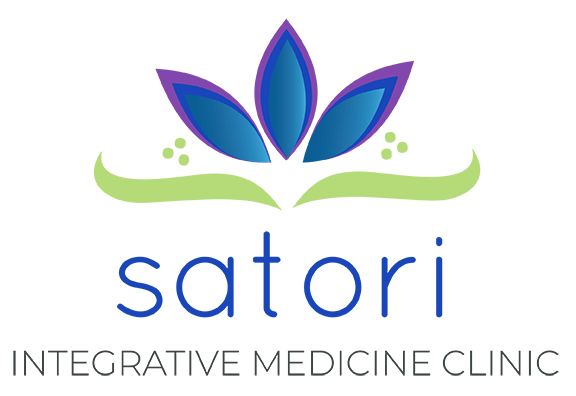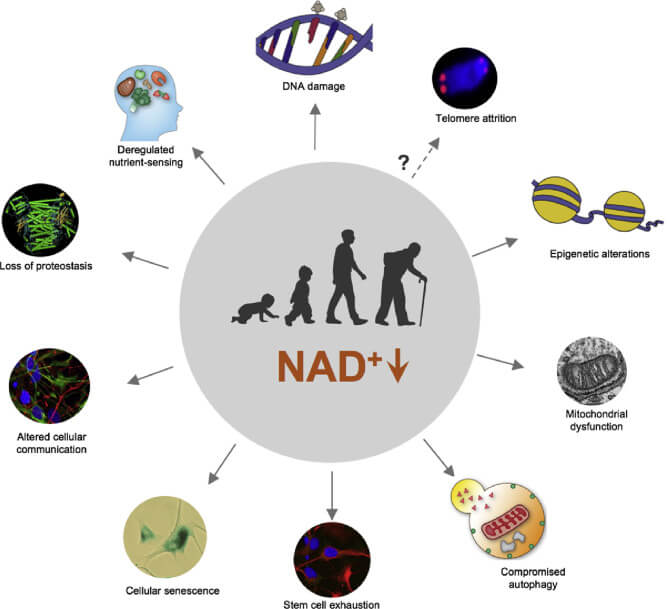We continue our ongoing series of blog posts, answering questions we get about different supplements. (Image credit: Science Direct.)
What is NAD+?
Nicotinamide adenine dinucleotide (NAD+) is found in every single living cell, where it serves as an essential cofactor — a substance whose presence is essential for the activity of enzymes — involved in fundamental biological processes. Since its discovery in 1906, research continues to show that NAD+ is critical for maintaining the health of our cells, producing energy, and protecting our DNA. It is involved in nearly every metabolic process in our bodies, and newer evidence indicates that it is important in cell-to-cell signaling and functions as a neurotransmitter in our autonomic nervous system (the part that controls things like blood pressure, goosebumps, and some of the “flight-or-fight” response).
We get NAD+ either by creating it from nutritional building blocks including the amino acid tryptophan or from what biologists refer to as a “salvage pathway” where the “used up” version of NAD+ is rebuilt using vitamins like B3. Both of these processes use a complex array of cofactors, enzymes, and other building blocks to make the working version of NAD+.
How is NAD+ related to health?
NAD+ is concentrated in the mitochondria of our cells. Its most commonly understood function comes as a critical component of cellular energy creation. A good, if not-quite-perfect, analogy is to think of the mitochondria as the power plant of the cell and the NAD+ as the fuel for the power plant. It also helps regulate cellular protein production and other processes important to the life-cycle and productivity of cells in our bodies. It is an essential cofactor for the activity of two classes of genes related to metabolism and aging PARPs and Sirtuins. The way these entities work is extremely complex and varied but they don’t work well, and sometimes not at all, without NAD+. Sirt1, for example, appears to play a role in preventing depression, age-related cognitive dysfunction, autoimmune disease, and regulation of metabolism (fat / obesity in particular). This group of genes are also actively involved in DNA repair and cellular aging – think cancer and aging here. All of these functions require NAD+.
During the aging process, NAD+ levels decline, and many enzymes associated with NAD+ creation and salvage are altered. Many of the cellular processes that influence or are influenced by aging — such as metabolic dysfunction, DNA repair failure, genomic instability, inflammation, cellular senescence, and neurodegeneration — are greatly influenced by NAD+ levels.
This decline in NAD+ levels during aging has been linked to the development and progression of aging-related diseases, including atherosclerosis, arthritis, hypertension, cognitive decline, diabetes, and cancer.
Research indicates that alterations in immune responses accompany aging, including a reduced ability of the immune system to protect against infectious diseases and the reduced efficacy of vaccines in older adult populations. Virus infections in particular have been dubbed “NAD+ Battlegrounds” (link to article) because they hijack the cell’s own protein production mechanism to make more copies of itself. Of course, all of those production mechanisms use NAD+! In response, the cells initiate a process called innate immunity which also uses lots of NAD+. Mounting evidence indicates that post-viral syndromes, including post-COVID or long-COVID may actually indicate whole-body symptomatic depletion of NAD+.
Using NAD+ or its precursor molecules as an immunomodulator in patients infected by COVID-19 may lead to positive outcomes – research is still early stages. Restoring normal NAD+ levels could decrease the severity of immune reaction in those patients and improve their clinical condition. Recent studies have shown that NAD+ has the potential to decrease recovery time in people with mild-to-moderate COVID-19.
How can NAD+ levels be improved?
Some potential strategies that boost NAD+ levels include lifestyle changes, such as increasing exercise, reducing caloric intake, eating a healthy diet, and following a consistent daily circadian rhythm pattern by conforming to healthy sleeping habits and mealtimes.
All of these approaches help improve tissue NAD+ levels. These benefits can include improved tissue and organ function, protection from cognitive decline, improved metabolic health, reduced inflammation, and increased physiological benefits, such as increased physical activity, which may collectively extend a person’s lifespan.
Oral forms of NAD+ are available but are expensive and NAD+ doesn’t generally make it through the GI system to the cells where it can be effective. Supplementing with the oral building blocks can be helpful and we have highlighted some of the supplements we use in this month’s newsletter. The most efficient way to increase your NAD+ is through IV supplementation – an IV is effective immediately, is nearly 100% bioavailable (directly into the blood stream) and does not require other compounds or enzymes to create the final product.
If this post has sparked your interest here are a couple of articles you may enjoy:
- Therapeutic potential of boosting NAD+ in aging and age-related diseases – ScienceDirect
- Viral infection as an NAD+ Battlefield
***
At Satori Integrative Medicine Clinic, we encourage our patients to incorporate lifestyle practices into daily life as part of a comprehensive treatment plan for: major depression, the depressed phase of bipolar disorder (bipolar depression), postpartum depression, anxiety, post-traumatic stress disorder (PTSD), obsessive compulsive disorder (OCD), pain syndromes such as fibromyalgia and complex regional pain syndrome (CRPS), also known as reflex sympathetic dystrophy (RSD), and addiction. Our services include integrative medicine, ketamine and lidocaine infusions, IV supplements, and medical acupuncture. If you or someone you know suffers from any of these conditions and this approach to health and wellness resonates with you, please contact us for more information.


Recent Comments